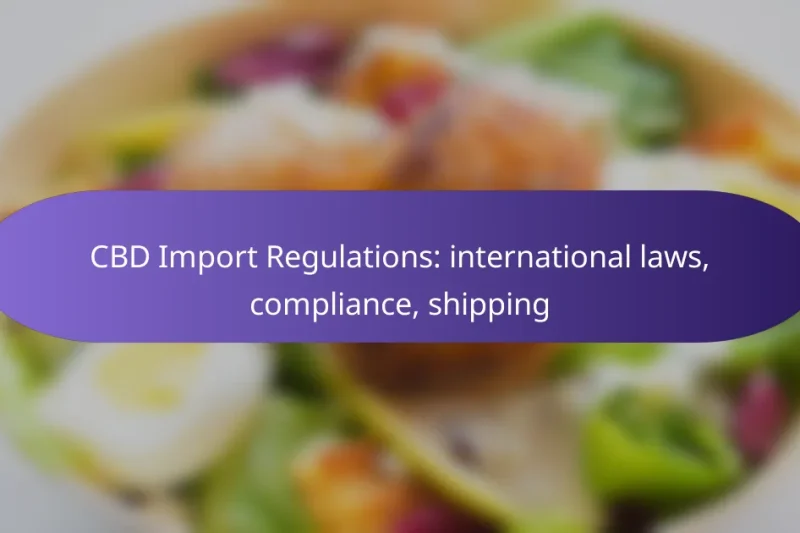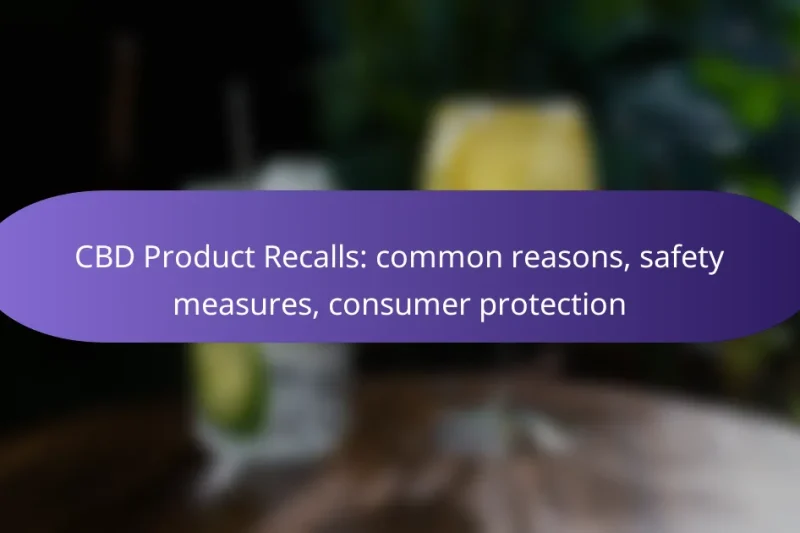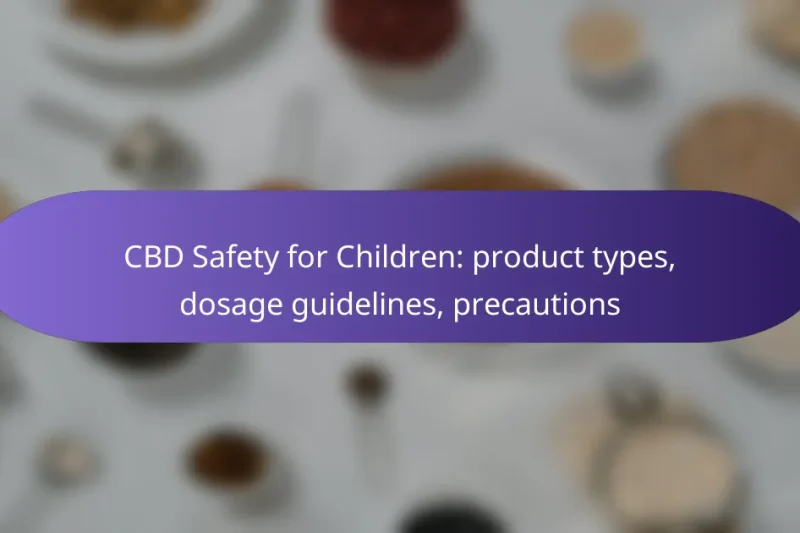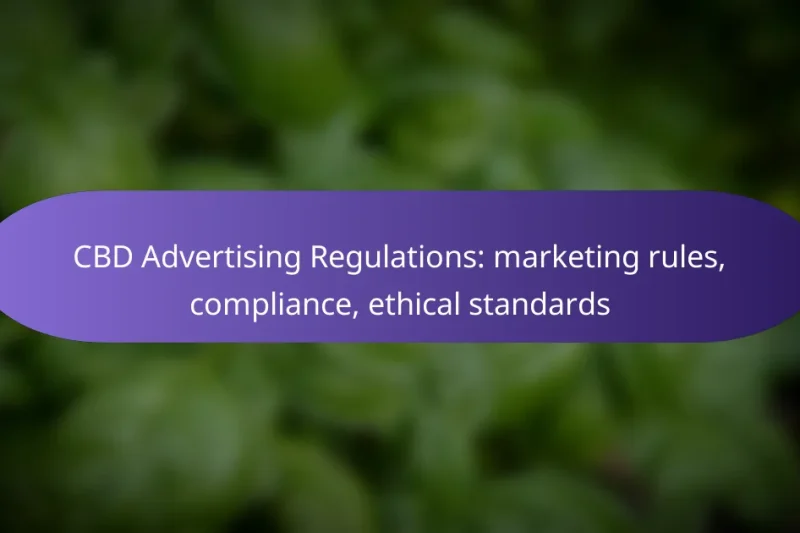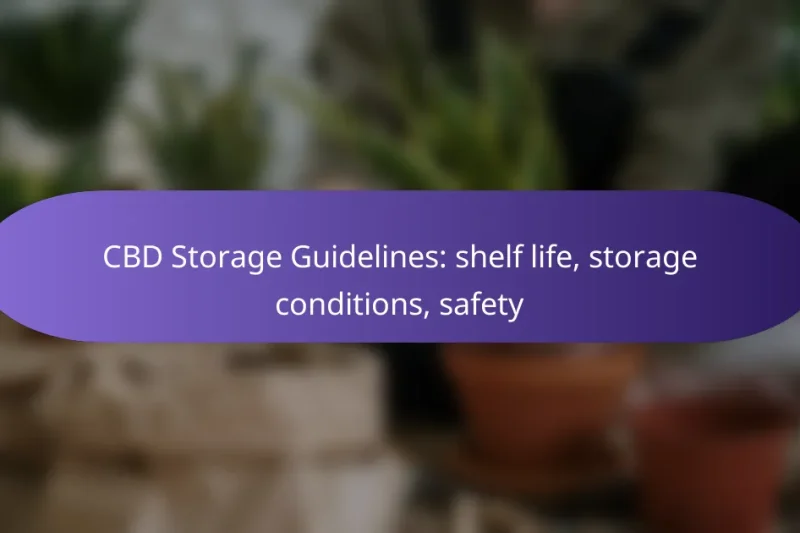CBD has emerged as a popular option for stress relief, with various product types such as … CBD for Stress Relief: product types, usage methods, effectivenessRead more
Understanding CBD Product Regulations and Safety
Understanding CBD product regulations is crucial for both consumers and businesses, as these laws can differ widely across federal and state levels. To ensure safety, it’s important to choose products that have been rigorously tested and comply with quality standards, including verification through third-party lab results. Additionally, proper labeling is essential for transparency, providing consumers with vital information about contents, usage, and health warnings.
CBD Import Regulations: international laws, compliance, shipping
Navigating the import regulations for CBD products requires a thorough understanding of both federal and state … CBD Import Regulations: international laws, compliance, shippingRead more
CBD Product Recalls: common reasons, safety measures, consumer protection
CBD product recalls are primarily driven by issues such as contamination, labeling errors, and safety standard … CBD Product Recalls: common reasons, safety measures, consumer protectionRead more
CBD for Skin Conditions: topical options, ingredient benefits, user feedback
CBD topicals, including creams, balms, and oils, are increasingly popular for addressing various skin conditions due … CBD for Skin Conditions: topical options, ingredient benefits, user feedbackRead more
CBD Safety for Children: product types, dosage guidelines, precautions
As interest in CBD for children grows, it is essential to prioritize safety by selecting products … CBD Safety for Children: product types, dosage guidelines, precautionsRead more
CBD Advertising Regulations: marketing rules, compliance, ethical standards
Navigating the advertising regulations for CBD products in the United States requires a thorough understanding of … CBD Advertising Regulations: marketing rules, compliance, ethical standardsRead more
CBD Manufacturing Practices: GMP standards, quality control, safety
In the rapidly evolving CBD industry, adherence to Good Manufacturing Practices (GMP) is crucial for ensuring … CBD Manufacturing Practices: GMP standards, quality control, safetyRead more
CBD Product Testing: lab results, quality assurance, safety standards
CBD product testing is crucial for ensuring the quality and safety of these items, providing consumers … CBD Product Testing: lab results, quality assurance, safety standardsRead more
CBD Storage Guidelines: shelf life, storage conditions, safety
Proper storage of CBD products is crucial for maintaining their quality and safety. To ensure a … CBD Storage Guidelines: shelf life, storage conditions, safetyRead more
CBD Labeling Requirements: dosage information, ingredient lists, compliance
CBD labeling requirements in the United States mandate clear dosage information, comprehensive ingredient lists, and adherence … CBD Labeling Requirements: dosage information, ingredient lists, complianceRead more
What are the current CBD product regulations in the United States?
The current CBD product regulations in the United States are primarily governed by federal and state laws, which can vary significantly. Understanding these regulations is essential for consumers and businesses to ensure compliance and safety in the market.
Federal regulations overview
At the federal level, the Food and Drug Administration (FDA) oversees the regulation of CBD products. The FDA has approved Epidiolex, a CBD-based medication for specific medical conditions, but other CBD products remain largely unregulated, particularly in terms of labeling and health claims.
CBD derived from hemp is legal under the 2018 Farm Bill, provided it contains less than 0.3% THC. However, the FDA has not established clear guidelines for the marketing of CBD products, leading to a patchwork of compliance issues across the industry.
State-specific regulations
State regulations for CBD products can differ widely, with some states imposing strict rules while others have more lenient approaches. For instance, states like California and Colorado have comprehensive regulations that cover production, testing, and sales, ensuring consumer safety.
Conversely, some states may have minimal regulations, which can lead to inconsistencies in product quality and safety. Consumers should research their specific state’s laws to understand what is permissible and what standards are enforced.
Impact of the 2018 Farm Bill
The 2018 Farm Bill significantly changed the landscape for CBD by legalizing hemp-derived CBD at the federal level. This legislation allowed for the cultivation of hemp and the production of CBD products, provided they meet the THC threshold.
As a result, the market for CBD has expanded rapidly, but the lack of clear FDA regulations means that consumers must be cautious. It’s advisable to look for third-party lab testing and transparent sourcing when purchasing CBD products to ensure safety and compliance with existing laws.
How to ensure CBD product safety?
To ensure CBD product safety, consumers should look for products that have undergone rigorous testing and adhere to quality standards. This includes verifying third-party lab results and understanding the manufacturing processes involved.
Third-party lab testing
Third-party lab testing is essential for confirming the safety and potency of CBD products. Reputable manufacturers will send their products to independent labs for analysis, which checks for cannabinoid content, contaminants, and overall quality. Consumers should always request or check for these lab results before purchasing.
Look for Certificates of Analysis (COAs) that provide detailed information about the product’s composition. A trustworthy product will typically show that it is free from harmful substances like pesticides, heavy metals, and solvents.
Quality control standards
Quality control standards are critical in the CBD industry to ensure consistent product safety and efficacy. Manufacturers should follow Good Manufacturing Practices (GMP) to maintain high-quality production processes. This includes proper sourcing of raw materials, cleanliness in production facilities, and regular equipment maintenance.
Additionally, consumers can benefit from choosing brands that are transparent about their sourcing and production methods. Look for companies that provide clear information on their cultivation practices and extraction methods, as these factors significantly influence product quality.
What are the labeling requirements for CBD products?
CBD products must adhere to specific labeling requirements to ensure consumer safety and transparency. These regulations typically include information about the product’s contents, usage instructions, and any potential health warnings.
Mandatory information on labels
Labels on CBD products must include essential details such as the product name, the amount of CBD per serving, and the total volume or weight of the product. Additionally, manufacturers are required to list all ingredients, including any additives or flavorings.
Health warnings and disclaimers are also crucial. For example, products should indicate that they are not intended to diagnose, treat, cure, or prevent any disease. Furthermore, if the product contains THC, the label must specify the amount to ensure compliance with local regulations.
Common labeling mistakes
One frequent mistake is omitting the total CBD content or failing to provide clear serving sizes, which can confuse consumers. Labels should be straightforward and easy to read, avoiding technical jargon that may mislead customers.
Another common error is not including necessary warnings or disclaimers, which can lead to regulatory issues. Manufacturers should ensure that all required information is present and accurate to avoid potential legal repercussions and maintain consumer trust.
How do CBD regulations vary by state?
CBD regulations differ significantly across states in the U.S., affecting everything from product legality to labeling requirements. Understanding these variations is crucial for consumers and businesses to ensure compliance and safety.
State-by-state comparison
Each state has its own set of laws governing CBD, which can include restrictions on THC content, product types, and sales channels. For instance, some states allow CBD derived from hemp with less than 0.3% THC, while others may have stricter limits or require specific licenses for sale.
Additionally, states may vary in how they regulate CBD-infused food and beverages. Some states permit these products, while others prohibit them entirely, leading to a patchwork of regulations that can confuse consumers and businesses alike.
Examples of strict vs. lenient states
Strict states like Idaho and Nebraska have stringent laws that classify all forms of CBD as illegal unless they meet specific criteria, such as being derived from approved hemp strains. In contrast, states like California and Colorado have embraced a more lenient approach, allowing a wide range of CBD products, including edibles and topicals, with minimal restrictions.
For example, in California, CBD products can be sold in retail stores and online, provided they comply with labeling and safety standards. Meanwhile, in Idaho, even low-THC CBD products face significant legal hurdles, making it challenging for consumers to access these items safely.
What are the risks associated with CBD products?
CBD products can pose various risks, including potential side effects and contamination issues. Understanding these risks is essential for consumers to make informed decisions about their use.
Potential side effects
Common side effects of CBD products may include fatigue, changes in appetite, and diarrhea. While many users tolerate CBD well, some may experience adverse reactions, especially at higher doses.
It is advisable to start with a low dose and gradually increase it while monitoring your body’s response. Consulting with a healthcare professional before starting CBD can help mitigate risks, particularly for individuals with existing health conditions or those taking other medications.
Contamination risks
Contamination of CBD products can occur due to poor manufacturing practices or the use of low-quality hemp. This can lead to the presence of harmful substances such as pesticides, heavy metals, or residual solvents.
To minimize contamination risks, consumers should look for products that have undergone third-party testing and provide a Certificate of Analysis (COA). This document confirms that the product has been tested for purity and potency, ensuring it meets safety standards.
What should consumers look for in CBD products?
Consumers should prioritize quality, transparency, and safety when selecting CBD products. Key factors include the source of the hemp, third-party testing, and clear labeling of ingredients and concentrations.
Key attributes to consider
When evaluating CBD products, consider the extraction method used. CO2 extraction is often preferred for its purity and safety, while solvent-based methods may leave harmful residues. Additionally, check the concentration of CBD; products typically range from 5 mg to 50 mg per serving, depending on the intended use.
Look for full-spectrum, broad-spectrum, or isolate options based on your preferences. Full-spectrum products contain a range of cannabinoids and terpenes, which may enhance effects, while isolates provide pure CBD without other compounds. Always review the product’s Certificate of Analysis (COA) for verification of contents.
Reputable brands and certifications
Choose CBD products from reputable brands that provide transparency about their sourcing and manufacturing processes. Look for companies that have third-party testing to confirm the potency and purity of their products. Certifications from organizations like the U.S. Hemp Authority can also indicate adherence to high standards.
Research customer reviews and brand reputation within the industry. Brands that engage with consumers and provide educational resources often demonstrate commitment to quality and safety. Avoid products that lack clear labeling or have vague claims about their benefits.
How to navigate CBD product compliance?
Navigating CBD product compliance involves understanding the legal landscape and adhering to regulations that vary by region. Key aspects include labeling requirements, THC content limits, and safety testing protocols.
Steps for e-commerce businesses
For e-commerce businesses selling CBD products, the first step is to research the specific regulations in the regions where you plan to operate. This includes understanding federal, state, and local laws regarding CBD sales, as they can differ significantly.
Next, ensure that your products meet labeling requirements, which typically include clear ingredient lists, serving sizes, and disclaimers about THC levels. Many regions require that products contain less than 0.3% THC to be legally sold.
Additionally, consider implementing third-party lab testing to verify product safety and potency. This not only builds consumer trust but also helps ensure compliance with safety standards. Regular audits of your supply chain and product offerings can help avoid common pitfalls in the rapidly evolving CBD market.

